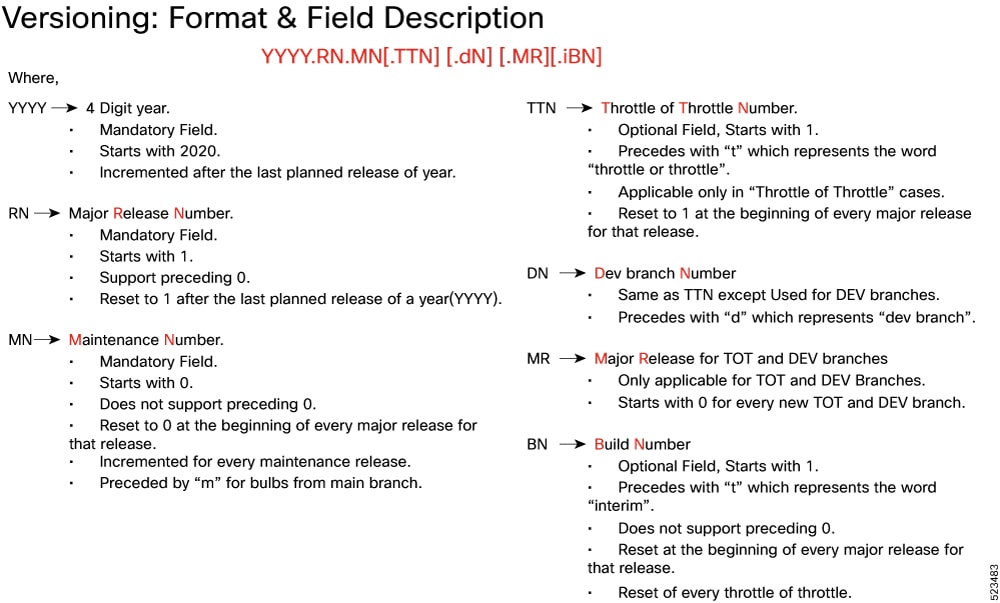5G Converged Core Session Management Function
Introduction
This Release Notes identifies changes and issues related to this software release.
Release Lifecycle Milestones
|
Release Lifecycle Milestone |
Milestone |
Date |
|---|---|---|
|
First Customer Ship |
FCS |
30-Apr-24 |
|
End of Life |
EoL |
30-Apr-24 |
|
End of Software Maintenance |
EoSM |
29-Oct-25 |
|
End of Vulnerability and Security Support |
EoVSS |
31-Oct-25 |
|
Last Date of Support |
LDoS |
31-Oct-26 |
These milestones and the intervals between them are defined in the Cisco Ultra Cloud Core (UCC) Software Release Lifecycle Product Bulletin available on cisco.com.
Release Package Version Information
|
Software Packages |
Version |
|---|---|
| ccg-2024.01.1.SPA.tgz | 2024.01.1 |
| NED package |
ncs-5.6.8-ccg-nc-2024.01.1 ncs-6.1-ccg-nc-2024.01.1 |
| NSO |
5.6.8 6.1.3 |
Descriptions for the various packages provided with this release are available in the Release Package Descriptions section.
Verified Compatibility
|
Products |
Version |
|---|---|
|
Ultra Cloud Core SMI |
2024.01.1 |
|
Ultra Cloud CDL |
1.11.6 |
|
Ultra Cloud Core UPF |
2024.01.0 |
|
Ultra Cloud cnSGWc |
2024.01.1 |
For information on the Ultra Cloud Core products, refer to the documents for this release available at:
What's New in this Release
New in Documentation
This version of Release Notes includes a new section titled What’s New in this Release comprising all new features, enhancements, and behavior changes applicable for the release.
This section will be available in all the 5G release notes and will supersede content in the Release Change Reference (RCR) document. Effective release 2024.01, the RCR document will be deprecated.
Features and Enhancements
This section covers a brief description of the features and enhancements introduced in this release. It also includes links to detailed documentation, where available.
| Feature | Description |
|---|---|
|
SMF with legacy interfaces allows IPv6 address configuration to enable communication with the GTP, N4, Gx, and Gy interfaces. With this support, both IPv4 and IPv6 addresses can be used for peer connections. One peer connection can use either IPv4 or IPv6 address. To enable IPv6 connectivity, SMF uses the existing endpoint { bgpspeaker | diameter | dns-proxy | geo | gtp | gtpprime | li | nodemgr | pfcp | protocol | radius | radius-dns | sbi | service | sgw-service } and dual-stack-transport { false | true } CLI commands. Default Setting: Disabled – Configuration Required |
Installation and Upgrade Notes
This Release Note does not contain general installation and upgrade instructions. Refer to the existing installation documentation for specific installation and upgrade considerations.
Software Integrity Verification
To verify the integrity of the software image you have from Cisco, you can validate the SHA512 checksum information against the checksum identified by Cisco for the software.
Image checksum information is available through Cisco.com Software Download Details. To find the checksum, hover the mouse pointer over the software image you have downloaded.

At the bottom you find the SHA512 checksum, if you do not see the whole checksum you can expand it by pressing the "..." at the end.
To validate the information, calculate a SHA512 checksum using the information in Table 1 and verify that it matches either the one provided on the software download page.
To calculate a SHA512 checksum on your local desktop, refer to the table below.
|
Operating System |
SHA512 checksum calculation command examples |
||
|---|---|---|---|
|
Microsoft Windows |
Open a command line window and type the following command:
|
||
|
Apple MAC |
Open a terminal window and type the following command:
|
||
|
Linux |
Open a terminal window and type the following command:
OR
|
||
|
|||
If the SHA512 checksum matches, you can be sure that no one has tampered with the software image or the image has not been corrupted during download.
If the SHA512 checksum does not match, we advise you to not attempt upgrading any systems with the corrupted software image. Download the software again and verify the SHA512 checksum again. If there is a constant mismatch, please open a case with the Cisco Technical Assistance Center.
Certificate Validation
SMF software images are signed via x509 certificates. Please view the .README file packaged with the software for information and instructions on how to validate the certificates.
Open Bugs for this Release
There are no open bugs in this software release.
Resolved Bugs for this Release
The following table lists the resolved bugs in this specific software release.
 Note |
This software release may contain open bugs first identified in other releases. Additional information for all resolved bugs for this release are available in the Cisco Bug Search Tool. |
|
Bug ID |
Headline |
Behavior Change |
|---|---|---|
|
IOT smf-service crash while running mon sub (version No ccg.2024.01.0) |
No |
Operator Notes
Cloud Native Product Version Numbering System
The show helm list command displays detailed information about the version of the cloud native product currently deployed.

The appropriate version number field increments after a version has been released. The new version numbering format is a contiguous sequential number that represents incremental changes between releases. This format facilitates identifying the changes between releases when using Bug Search Tool to research software releases.
Release Package Descriptions
The following table provides descriptions for the packages that are available with this release.
|
Software Packages |
Description |
|---|---|
|
ccg.<version>.SPA.tgz |
The SMF offline release signature package. This package contains the SMF deployment software, NED package, as well as the release signature, certificate, and verification information. |
|
ncs-<nso_version>-ccg-nc-<version>.tar.gz |
The NETCONF NED package. This package includes all the yang files that are used for NF configuration. Note that NSO is used for the NED file creation. |
Obtaining Documentation and Submitting a Service Request
For information on obtaining documentation, using the Cisco Bug Search Tool (BST), submitting a service request, and gathering additional information, refer to https://www.cisco.com/c/en/us/support/index.html.
 Feedback
Feedback